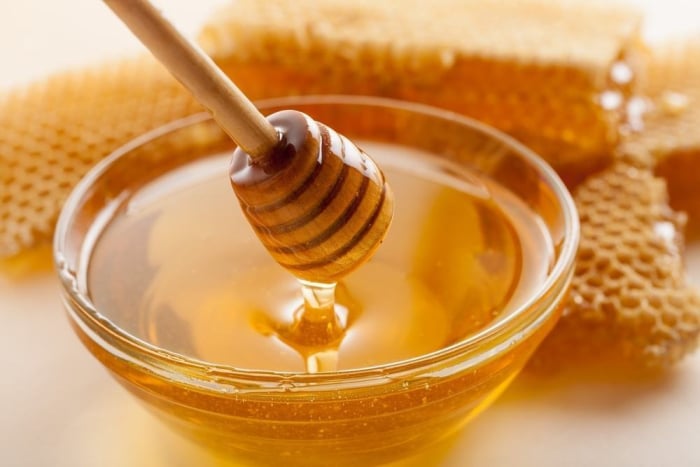Honey can get stale or not, right? Maybe If You Save It Wrong!

Honey is made by bees by processing nectar from flowering plants using enzymes found in their saliva. Due to its naturally sweet nature, honey is often used as a healthier substitute for sugar. The healthy benefits of honey also often make this yellow thick liquid used as a cure for various health problems to beauty treatments. So, can honey spoil?
Honey can go bad, right or not?
When shopping for honey at the nearest supermarket or shop, you may notice that the honey packaging has an expiration date on it. This is what makes many people think that honey can be spoiled. In fact, honey in its purest and natural form – without added sugar or other ingredients – can’t get stale.
Pure honey is very high in sugar. In fact, 80% of the honey content consists of natural sugars. This high sugar inhibits the growth of various types of microbes, such as bacteria and fungi. In addition, the water content in honey is very little which makes the texture very thick. This viscosity makes sugar unable to ferment and oxygen does not dissolve easily into it. That way, the microbes that cause rotten food cannot grow, let alone reproduce.

Honey also has an average pH level of 3.9 which indicates that this sweet liquid is acidic. Certain food contamination-causing bacteria, such as C. diphtheriae, E.coli, Streptococcus, and Salmonella, cannot thrive in an acidic environment. This acidic nature is what makes honey last for a very long time.
Then, pure honey has a special enzyme called glucose oxidase which works to suppress bacterial growth. This enzyme is contained naturally in bee saliva which is then dissolved into nectar (plant extract) during the honey production period.
When honey is ripe, the chemical process that converts sugar into gluconic acid will produce a compound known as hydrogen peroxide. These compounds give honey antibacterial and other antimicrobial properties such as polyphenols and flavonoids and thus help prevent the growth of the microorganisms that cause spoilage of food.
However, honey can decrease in quality
Honey can go bad is a wrong assumption. Pure honey has no expiration date. Even so, the quality of honey can decrease and therefore it can no longer be healthy, even at risk of causing disease, if it is contaminated by foreign microbes during the unhygienic production process.
Quoted from Healthline, spores of the neurotoxin C. botulinum were even found in some honey samples. These spores are harmless to adults, but can increase the risk of infant botulism. That’s why very young babies shouldn’t be fed honey.
In addition, several types of plant toxins can be carried in bee juice while collecting nectar. The most common are grayanotoxins from Rhododendron ponticum and Azalea pontica. The honey produced from this plant can cause dizziness, nausea and problems with heart rate and blood pressure if the production process is not strictly controlled. A substance known as hydroxymethylfurfural (HMF) can occur during the production of honey. Several studies have found evidence that HMF has negative effects on health, such as cell and DNA damage. For this reason, honey should not contain HMF more than 40 mg per kilogram.
Moreover, honey that is mass-produced in factories can be deliberately contaminated in various ways to reduce production costs. For example, bees are deliberately fed sugar syrup from corn (fructose). In addition, producers can pollute them by adding cheap sweeteners to honey. This artificial sugar can make packaged honey stale.
Not only that. To speed up the production process, honey is often harvested before it is ripe. As a result, honey has a water content that is higher than usual, so it risks experiencing fermentation and changes in taste. This causes the honey to spoil.
The wrong way to store honey can make it stale
If your pure honey is of very good quality but is stored incorrectly, it can lose its antimicrobial properties and then spoil. If the honey already looks foamy or runny, it’s better to throw it away. This indicates that the honey has been contaminated and is no longer fit for consumption.
To make the honey last longer, store it in an airtight, tightly closed container. Store in a cool, dry place, at room temperature around -10 to about 20º Celsius. Do not leave honey open, exposing it to the outside environment and increasing the risk of bacterial contamination from the surrounding air. Leaving the honey package open for a long time can also increase the moisture content, so the honey ferments and spoils quickly.
You can store the honey in the refrigerator. The honey will solidify slightly after a long period of refrigeration, but you can heat it briefly over low heat and stir until it returns to its original texture. Do not heat it over high temperatures or boil it with water as this will reduce its quality.
When taking honey from its container for processing or consumption, make sure you use clean and sterile utensils to scoop it out. Do not use the same tool to collect honey a second time. Remember to seal the honey container tightly after each use.
For more details, see the storage instructions on the packaging because the composition of each honey is different.
Hello Health Group does not provide medical advice, diagnosis or treatment.